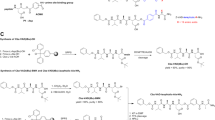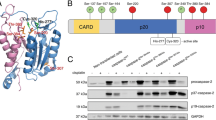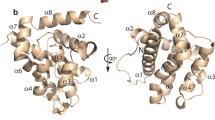Abstract
Apoptosis is a highly regulated process that is crucial for normal development and homeostasis of multicellular organisms1,2. The p35 protein from baculoviruses effectively prevents apoptosis by its broad-spectrum caspase inhibition3,4,5,6,7. Here we report the crystal structure of p35 in complex with human caspase-8 at 3.0 Å resolution, and biochemical and mutagenesis studies based on the structural information. The structure reveals that the caspase is inhibited in the active site through a covalent thioester linkage to p35, which we confirmed by gel electrophoresis, hydroxylamine treatment and mass spectrometry experiments. The p35 protein undergoes dramatic conformational changes on cleavage by the caspase. The repositioning of the amino terminus of p35 into the active site of the caspase eliminates solvent accessibility of the catalytic dyad. This may be crucial for preventing hydrolysis of the thioester intermediate, which is supported by the abrogation of inhibitory activity through mutations at the N terminus of p35. The p35 protein also makes conserved contacts with the caspase outside the active-site region, providing the molecular basis for the broad-spectrum inhibitory activity of this protein. We demonstrate a new molecular mechanism of caspase inhibition, as well as protease inhibition in general.
This is a preview of subscription content, access via your institution
Access options
Subscribe to this journal
Receive 51 print issues and online access
$199.00 per year
only $3.90 per issue
Buy this article
- Purchase on Springer Link
- Instant access to full article PDF
Prices may be subject to local taxes which are calculated during checkout



Similar content being viewed by others
References
Thompson, C. B. Apoptosis in the pathogenesis and treatment of disease. Science 267, 1456–1461 (1995).
Steller, H. Mechanisms and genes of cellular suicide. Science 267, 1445–1449 (1995).
Clem, R. J., Fechheimer, M. & Miller, L. K. Prevention of apoptosis by a baculovirus gene during infection of insect cells. Science 254, 1388–1390 (1991).
Bump, N. J. et al. Inhibition of ICE family proteases by baculovirus antiapoptotic protein p35. Science 269, 1885–1888 (1995).
Xue, D. & Horvitz, H. R. Inhibition of the Caenorhabditis elegans cell-death protease CED-3 by a CED-3 cleavage site in baculovirus p35 protein. Nature 377, 248–251 (1995).
Zhou, Q. et al. Interaction of the baculovirus anti-apoptotic protein p35 with caspases. Specificity, kinetics, and characterization of the caspase/p35 complex. Biochemistry 37, 10757–10765 (1998).
Ekert, P. G., Silke, J. & Vaux, D. L. Caspase inhibitors. Cell Death Differ. 6, 1081–1086 (1999).
Hay, B. A., Wolff, T. & Rubin, G. M. Expression of baculovirus P35 prevents cell death in Drosophila. Development 120, 2121–2129 (1994).
White, K., Tahaoglu, E. & Steller, H. Cell killing by the Drosophila gene reaper. Science 271, 805–807 (1996).
Beidler, D. R., Tewari, M., Friesen, P. D., Poirier, G. & Dixit, V. M. The baculovirus p35 protein inhibits Fas- and tumor necrosis factor-induced apoptosis. J. Biol. Chem. 270, 16526–16528 (1995).
Robertson, N. M. et al. Baculovirus P35 inhibits the glucocorticoid-mediated pathway of cell death. Cancer Res. 57, 43–47 (1997).
Hisahara, S. et al. Targeted expression of baculovirus p35 caspase inhibitor in oligodendrocytes protects mice against autoimmune-mediated demyelination. EMBO J. 19, 341–348 (2000).
Fisher, A. J., Cruz, W., Zoog, S. J., Schneider, C. L. & Friesen, P. D. Crystal structure of baculovirus P35: role of a novel reactive site loop in apoptotic caspase inhibition. EMBO J. 18, 2031–2039 (1999).
Zoog, S. J., Bertin, J. & Friesen, P. D. Caspase inhibition by baculovirus P35 requires interaction between the reactive site loop and the beta-sheet core. J. Biol. Chem. 274, 25995–26002 (1999).
Sambrook, J., Fritsch, E. F. & Maniatis, T. Molecular Cloning, 2nd edn (Cold Spring Harbor Laboratory Press, New York, 1989).
Bruice, T. C. & Benkovic, S. J. Bioorganic Mechanisms (Benjamin, New York, 1966).
Owen, W. G., Penick, G. D., Yoder, E. & Poole, B. L. Evidence for an ester bond between thrombin and heparin cofactor. Thromb. Haemost. 35, 87–95 (1976).
Stennicke, H. R. & Salvesen, G. S. Catalytic properties of the caspases. Cell Death Differ. 6, 1054–1059 (1999).
Watt, W. et al. The atomic-resolution structure of human caspase-8, a key activator of apoptosis. Structure Fold Des. 7, 1135–1143 (1999).
Blanchard, H. et al. The three-dimensional structure of caspase-8: an initiator enzyme in apoptosis. Structure Fold Des. 7, 1125–1133 (1999).
Bertin, J. et al. Apoptotic suppression by baculovirus P35 involves cleavage by and inhibition of a virus-induced CED-3/ICE-like protease. J. Virol. 70, 6251–6259 (1996).
Bode, W. & Huber, R. Structural basis of the endoproteinase–protein inhibitor interaction. Biochim. Biophys. Acta 1477, 241–252 (2000).
Wright, H. T. & Scarsdale, J. N. Structural basis for serpin inhibitor activity. Proteins 22, 210–225 (1995).
Huntington, J. A., Read, R. J. & Carrell, R. W. Structure of a serpin–protease complex shows inhibition by deformation. Nature 407, 923–926 (2000).
Tong, L. REPLACE, a suite of computer programs for molecular-replacement calculations. J. Appl. Cryst. 26, 748–751 (1993).
Jones, T. A., Zou, J. -Y., Cowan, S. W. & Kjeldgaard, M. Improved methods for building models in electron density maps and the location of errors in those models. Acta Crystallogr. A 47, 110–119 (1991).
Brunger, A. T. et al. Crystallography & NMR system: a new software suite for macromolecular structure determination. Acta Crystallogr. D 54, 905–921 (1998).
Park, Y. C. et al. A novel mechanism of TRAF signaling revealed by structural and functional analyses of the TRADD–TRAF2 interaction. Cell 101, 777–787 (2000).
Myszka, D. G. Improving biosensor analysis. Mol. Recogn. 12, 1–6 (1999).
Myszka, D. G. & Morton, T. A. CLAMP: a biosensor kinetic data analysis program. Trends Biochem. Sci. 23, 149–150 (1998).
Acknowledgements
We thank K. D'Amico for access to the COM-CAT beamline at the APS; C. Ogata for access to the X4A beamline at NSLS; L. Tong for help with data collection and for critical reading of the manuscript; J. Kerwin for mass spectrometry experiments; J. Luft and G. DeTitta for initial screening of crystallization conditions for a p35/caspase-3 complex, which served as leads for the crystallization of the p35/caspase-8 complex; and C. Lima, T. Muir, B. Chait, G. Dodson, H. T. Wright and T. Begley for insightful discussions. This work was supported by the Speaker's Fund for Biomedical Research and the departmental startup fund. H.W. is a Pew Scholar in the Biomedical Sciences.
Author information
Authors and Affiliations
Corresponding author
Supplementary information
Rights and permissions
About this article
Cite this article
Xu, G., Cirilli, M., Huang, Y. et al. Covalent inhibition revealed by the crystal structure of the caspase-8/p35 complex. Nature 410, 494–497 (2001). https://doi.org/10.1038/35068604
Received:
Accepted:
Issue Date:
DOI: https://doi.org/10.1038/35068604
This article is cited by
-
A Review on Caspases: Key Regulators of Biological Activities and Apoptosis
Molecular Neurobiology (2023)
-
Microbial inhibitors of cysteine proteases
Medical Microbiology and Immunology (2016)
-
Caspase signalling in the absence of apoptosis drives Jnk‐dependent invasion
EMBO reports (2013)
-
Allosteric peptides bind a caspase zymogen and mediate caspase tetramerization
Nature Chemical Biology (2012)
-
Caspase cleavage of viral proteins, another way for viruses to make the best of apoptosis
Cell Death & Disease (2012)
Comments
By submitting a comment you agree to abide by our Terms and Community Guidelines. If you find something abusive or that does not comply with our terms or guidelines please flag it as inappropriate.



